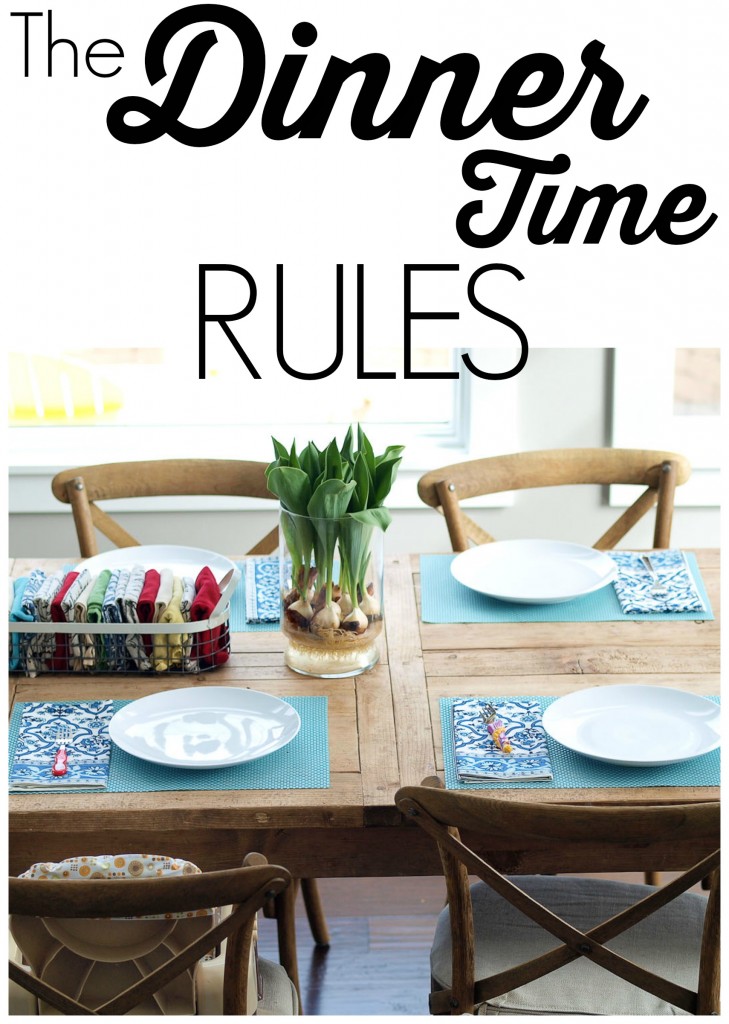A while back I got an email from a reader asking if I could “pull back the curtain” on how I handle dinnertime. I love getting topic requests from readers, but I found that choice of words a little odd. It made me feel as if I’m hiding something. I assure you that I’m not.
I can see, however, that it may appear like I’m trying to create some sort of illusion that my kids eat and love everything. They don’t. Maybe some of you come to the conclusion that my kids must eat every single thing I post on here. They don’t. Perhaps you assume I choose only healthy foods for my kids. Sometimes yes, sometimes no. My choices are far from perfect, but I do try my best to feed them well.
So come on in. Welcome to our dinner table. This is how we do things.
When Meghan was an infant and toddler, I read a lot of books on feeding and nutrition for children. Of course, as a first time mom, I was concerned about doing everything “right.” The one author’s ideas I tried to emulate the most was Ellyn Satter. She made it sound so simple and straightforward.
Her philosophy, in a nutshell, is that the parents decides what and when the children eat, the children decide how much they will eat. Her philosophy calls for making just one meal for dinner (no short order cooking), always including at least one thing the child likes on her plate, and never, ever forcing the child to eat more for any reason, especially not to get dessert. She even talks about serving dessert right along with dinner.
So I tried that for a while with Meghan and ended up with a three year old who wouldn’t eat any vegetables. I gave her the choice and she chose not to eat them. Trust me. She had vegetables in front of her at every lunch and dinner, but no pressure to eat them. I was stressed.
I finally had to try my own method, which I called Operation Eat More Vegetables, to get her eating them again like she did as a younger toddler. It worked, and it convinced me that I could stop worrying about doing things right and just follow my instincts.
Fast forward to today, and our dinner table includes Meghan as a 6 year old and our 3 year old Luke. Our dinner time rules have morphed from all I’ve read from the experts out there, but mostly from my and Tim’s instincts about what is going to work for us. I’m sure some of the experts would look at how we handle mealtime and have some advice to give us on what we should change. Sometimes, though, parents acting on instincts are the best experts of all.
My kids are totally normal kids. Sometimes they eat really well and I feel proud of them. Other times they just don’t and I want to bang my head on the table. There are the kids out there who were born loving sushi and would eat just about anything you put in front of them. My kids aren’t those types. I have to work to get them trying and liking new things.
That brings us to our dinnertime rules. I call them rules because that’s a convenient word, but really they are more like guidelines, a how-to manual of sorts.
1. We always eat dinner together at the table.
We do this every night. Sometimes that means our snack and dinner times have to shift because of activities, but I almost always work it so we can eat dinner together. I’m glad we started this habit now while the kids are young because I think it will make it easier to reinforce as they get older.
2. You must eat what I prepared for you for dinner–I’m not getting up to get you something different.
What I mean by this is if I put something in front of Meghan, she can’t say, “I don’t want to eat this tonight, I want _____.”
What that doesn’t mean is that the kids always eat the exact same thing as we do. I respect their personal preferences and try to keep them in mind when I prepare dinner, while always trying to expand them.
The most common example of this in action is the kids eating a deconstructed version of what we are eating. Take this Quick and Easy Chicken Pumpkin Chili. Tim and I would get the chili in a bowl, the kids would get the beans, chicken, and peppers on a plate, all separated. I do encourage them to eat things mixed up by giving them a tiny portion of the meal as I made it, but it’s a very long process as they really don’t want to. At this point Meghan is much more open to trying new things than Luke, but she still is very hesitant to try mixed together foods.
If I’m deconstructing a dinner for the kids and there are parts they won’t like as much, I’ll add something to their plate to round out the meal, like some extra beans or cheese. It’s usually just something I can grab and add to their plate, not something that makes too much more work for me.
Sometimes, I want to make something that I absolutely know the kids won’t like, and there’s no way to deconstruct it. For example, my kids don’t like pasta. It’s a tragedy, I tell you! Pasta is pretty much my favorite thing on earth, so do I simply give up on eating pasta for dinner because my kids don’t like it? Nope.
If I’m serving a pasta dish that I can’t deconstruct, like this 30 Minute Skillet Lasagna, they kids will usually get something that’s already prepared, such as leftovers.
3. There’s no Clean Plate Club at our house.
I don’t force my kids to eat all their food. I’m trying to teach them to stop eating when they are satisfied, not overstuffed. That’s a hard skill for many adults. (Myself included sometimes!) I’ll often ask, “Does your stomach feel like it’s had enough?” It’s a tricky balance to strike. On one hand, obesity is a major problem, and childhood obesity is currently at a historically high level. On the other hand, eating disorders are also common. I just want my kids to have a healthy relationship with food and learn to understand their bodies and how to respond to hunger levels. I don’t think forcing them to clear their plates will help me reach that goal.
They do know that whether they clear their plate or leave food on there, they won’t be heading to the pantry to grab a snack 10 minutes after dinner. We typically eat a pretty early dinner, so I do allow a snack before bed, but they won’t get a snack in between dinner and bedtime.
4. Taste everything.
….once you get to a certain age. We don’t require Luke to taste everything just yet, but we do encourage it. Meghan tastes everything on her plate. For a long time this was a struggle, but now it’s usually easy. She knows I’m not going to force her to eat everything, so tasting is a safe activity. Most of the time, she does eat everything I serve her. There are certain things she just doesn’t like, so she eats a bite and says, “No, thank you.”
Toddlers are a whole different ball game, and Luke is hit or miss. Some nights he eats everything without issue, and the next night he looks at his favorite foods and won’t eat one bite. When he’s around 3 1/2 or 4 years, we will start requiring him to taste everything.
5. If you don’t eat any (or very little) dinner, you don’t get something different for snack.
I mentioned that I allow my kids to have a snack before bed. I am always hungry in the evening, too, so I understand that they probably have my metabolism and really do feel hungry 2-3 hours after dinner. If they don’t eat any, or very little of, their dinner, then I save the dinner and serve it to them as their snack before bed. This is to prevent them from skipping dinner because they know they can hold out until snack time. This rarely happens with Meghan anymore; I can’t remember the last time.
It happens more often with Luke. It just happened last night, in fact. I joked to Tim that he is like a lion. The day before yesterday he ate all of his dinner and had seconds and thirds of some things. That was enough to hold him over for the next day, apparently. After he only ate a few bites of his fruit for dinner last night, he was offered the rest of his dinner for a snack before bed, and he refused. He went to bed fine and slept through the night, so I guess he really just wasn’t that hungry.
6. We eat vegetables and fruit with every meal.
This is true for every lunch and dinner. I wish I could say I offer them vegetables for breakfast, too, but I don’t. If for some reason I forget the fruit at dinnertime, Meghan is quick to remind me, “Wait–where’s the fruit?” Having fruit and vegetables at every meal helps make sure they are getting enough of them daily. I also work to offer different vegetables and fruits at every meal from day to day so they are getting a good variety.
7. We always use our manners.
Manners are really important to me, so I emphasize them a lot. Kids don’t just learn manners automatically. We have to reinforce them over and over. So every time one of them says, “I need more water!” our answer is “How do you ask?” We are consistent with requiring manners, so at this point they are good about saying please and thank you without prompting most of the time.
At dinnertime, manners extend beyond saying please and thank you. I also don’t let them say “Yucky!” about food they are eating. I remind them that it hurts my feelings when they say that about something I’ve prepared for them and please just say, “No thank you.” There are lots of reminders about this one.
We also all stay at the table while eating and don’t let them play with their food.
My hope is that by having manners be required at home, they will naturally use those same manners at school when eating lunch or when they are eating at a friend’s house.
I don’t think there’s a one-size-fits-all set of dinnertime rules that is going to work for every family. Work schedules may make it nearly impossible for everyone to sit together at dinner. Some people may be more strict than I am and simply require their children to eat the meal prepared (such as the pasta dishes I know my kids don’t like) no matter what. This is what works for my family.
Overall, I’m happy with our dinnertime. Do I wish my kids would happily eat every morsel of food I put in front of them? Of course. But I also know that’s not a realistic expectation. Maybe in five years I’ll be writing an entirely different set of dinnertime rules. For now, this is what we do. I hope sharing it with you will spark some ideas or conversations if you aren’t happy with what your dinnertime looks like currently.





U seem like a bit of a feminist who forces their kids to eat everything even if it causes them to gag anyways made my assignment ace cheers
Huh??
Yes that was random. Lol.
ANYWAYS….I love your ideas. You have good ideas. Thanks!
I really enjoyed reading this, Maryea! I think it’s awesome that you don’t force your kids to finish everything on their plate. I also adore how you encourage them to say “no thank you” rather than “yucky!” I’ll be calling you when I have kidddos!
I think you’ll be ahead of the game when you get to that point! 🙂
Thanks for writing this! I do have a question about your thoughts on handling dessert. I have 2 little ones also (younger than yours). We are a family that overall eats very healthy and have very little around the house in the way of sugary foods, no juice, no soda, etc. But as a former sufferer of an eating disorder I am very sensitive to not wanting my girls to develop a complex about food so it’s something I am always trying to mentally juggle. I’m not an official member of the clean your plate club, definitely. But if my 4-yr old eats everything on her plate and is still hungry, then she can have basically anything she chooses (i.e. more dinner, a different healthy food, or a dessert-like food we might have at the time) because I know she just got a great healthy meal in and is legitimately still a little hungry, so I think a treat is fine if that’s what she chooses. If I were to offer her the dessert up-front she would eat all of that and then just some dinner, guaranteed. If I let her have it after supper, she might not eat as much as she otherwise would so she would still have room for dessert. I could just get rid of all dessert-like items but I don’t want to be restrictive like that. But if she asks for something that we consider a treat before she is done eating her supper, it’s hard to know the best way to deal with that. See the conundrum? I want her to be able to have something sweeter here and there without it becoming a focus but I still don’t know the best way to go about that successfully. Anyway – sorry for the essay – would be curious on your thoughts since you put a lot of thought into this type of thing! 🙂
When she asks for something before she’s eaten her supper, I would ask yourself if you think she’d eat more independent of having another option. I really just want my kids to eat enough dinner to feel comfortable (not over-stuffed but not hungry anymore either). If my kids ask for something sweet after not eating everything, I handle it on a case by case basis depending on what they’ve eaten and what they are asking for. I don’t think the answer is black and white. Do I let my kids have a special treat (our special treats are usually pretty healthy treats) after dinner if they didn’t eat everything on their plate? I do. As long as they ate enough to get some good nutrition first, I’m okay with them not eating everything and still having a little sweet after dinner. We don’t have something sweet every single night, but a few nights a week we do. There are definitely times when they ask for something sweet before they’ve eaten what I consider to be enough dinner, and I say no, you can’t have a special treat until you’ve eaten more dinner. I don’t think there’s anything wrong with that. I know some experts say don’t do that. I disagree. There’s nothing wrong, in my opinion, with understanding that special treats are just that, special, and to be eaten only in small amounts after we’ve eaten the foods that give us energy and help us grow. I explain that to my kids and I think they understand it pretty well. I hope this helps!
I need to use some of these with my husband lol. When his youngest is with us I try to have either the table in the dining room or sunroom set. He’d prefer the living room but I ask Ana where she wants to eat usually it’s the sunroom.
I did grow up in a household with depression era parents, and the clean plate club, and I (and my three siblings) won’t touch lima beans to this day because of that! We had to finish them to get the candy for dessert, and we didn’t even want the candy, but we still had to finish the lima beans. Thankfully that did not affect our love for all other kinds of beans. (One of my favorite children’s books – about a little girl and her lima beans – that I read to my children when they were younger, is called “A Bad Case of Stripes” by David Shannon. Your kids would love this! It has great illustrations too!) Needless to say, I did not make my girls finish their plates and I coached them the same way as you, to pay attention to their tummy and stop when they feel full, and so far, they are college age and have a healthy relationship with food, and they try most everything, and they have not gained the “Freshman 15” and have beautiful trim figures. You’re on the right track!
Thanks for your reassurance, Carol! I had a similar experience with green peas growing up. A babysitter made me eat them all before I could have dessert. It took me a long, long time to ever eat green peas again. I think I was around 30! I will have to check out that book, too.
Great rules! I’m so glad that the “clean plate club” is gone! I hated that as a child. We’re really working to establish rules now that Harper’s so opinionated. I can’t wait to incorporate some of these.
I hope they help! 🙂
These are great tips! Lots of these reminded me of the way I ate as a kid. We always had dinner at the kitchen table, & we were never forced to eat everything on our plate. We definitely did have the rule of if you didn’t eat your veggies you couldn’t have dessert. It worked most of the time, but I see now how it’s not good to reward your kids w/ sugar, if they eat their greens. So much great info out there today for feeding kids. I love your kitchen table! I’ve been looking for a new one and it’s gorgeous.
We have the taste everything rule too-but we start implementing it at age 3. Before that I agree with you, it’s useless to argue with someone that for all intents and purposes is still an infant. After age 3, however, I feel they are much more a kid (usually they are potty trained, going to school, etc.). I have found that age works great to start requiring them to taste all their food.
Do you have any battles about it? Right now Luke is pretty stubborn and the last thing I want is to fight with him every night at the dinner table. I feel like he doesn’t understand the concept just yet. I could be underestimating him, though. 😉
No, no battles at all actually. When we tried before age 3 it was truly like trying to talk sense to a baby. But we found once they hit three they can understand and communicate with you. If you are having conversations with him and discussing why things do or do not happen already, meal time is no different than any other experience. Now I do know some three year olds that would have *no* concept of this, but it shows in other areas of their lives-like they can’t do time outs b/c they just don’t understand, you can’t reason with them on behavior issues and have to treat them more like infants (redirection, taking the object away, etc.) But for the most part-give or take a few months-three year olds get it.
That’s great! I think that Luke may just need a few more months. 🙂
This sounds li my house!
I can say I follow most of your rules, most of time, and agree with them all. I only wish I did them all of the time.
There are always exceptions to the rules, right?! It’s okay. 🙂
I like your There’s no Clean Plate Club at our house rule. I grew up in the era where you had to clean your entire plate and I can plainly see how this was a problem! I liked your post, thanks for sharing your ideas!
You’re welcome, Amber. 🙂
I love your rules! I may have to start using some of these in my house.